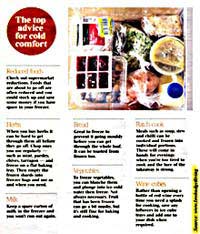
The fridge-freezer is one of the biggest energy-consumers in your home – are you using it efficiently? Here are tips on using your freezer to save energy.
How Your Freezer Works
Essentially, your freezer works by pumping a refrigerant gas through coils that cool the interior. In a frost-free freezer, the procedure is a bit more complicated; the icy coils that chill the freezer contents are continually warmed and then cooled, so that ice forms and then melts off them. For this reason, a frost-free freezer uses more energy than an old-style freezer. If you’re choosing a chest freezer for storing your vegetables, you’ll probably look at non-frost-free models. You get more frost, but longer storage life for the contents. But be careful: let the frost build up too much, and your freezer will consume extra energy.
Using your Freezer Efficiently
As well as defrosting it now and again (see below), there are a few things you can do to make sure your freezer is running efficiently – and save energy too!
A Savaplug could save energy by reducing the flow to your freezer when it’s not working very hard. Developed by the Department of Energy, this plug can be used for fridges or freezers.
If your freezer has condensation on the outside, too much ice inside, or it’s just not working as well as it used to, check the seals – these are a common problem. Put a torch inside the freezer, shut the door, and look for light leaking out. You can replace door seals for far less than the entire freezer. If the seals are working, you can check the interior temperature using a fridge thermometer. It should be around -18 degrees C.
If you have a half-empty freezer, here’s a tip: fill it up. If there is too much space (and air) in your freezer, the coils are working harder to cool it all. To save energy, fill the space. You could use it to store spirits, fruit, or bulk supplies of your favourite frozen veg. If you don’t have anything to put in, fill the space with plastic milk cartons that you’ve filled with water.
How to Defrost your Freezer
For a couple of weeks before defrosting, try to use up most of your frozen produce. Throw out anything without a label and any dairy that’s more than 3 months old. On defrosting day, store the rest of the freezer contents into a cool box, or wrap them in newspaper and put in a cool place for the day.
Unplug the freezer and put some trays beneath the machine to catch any drips. To speed up the defrosting, you could put a bowl of boiling water on the bottom shelf – and some people swear by the hairdryer to defrost speedily! Once the ice has melted, wipe your freezer with antibacterial detergent, dry it off and plug it back in – let it run for an hour before returning the food to the drawers.
